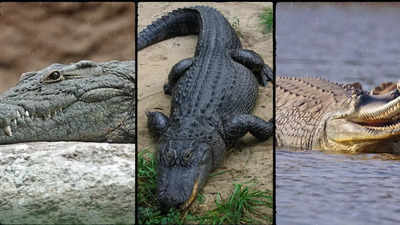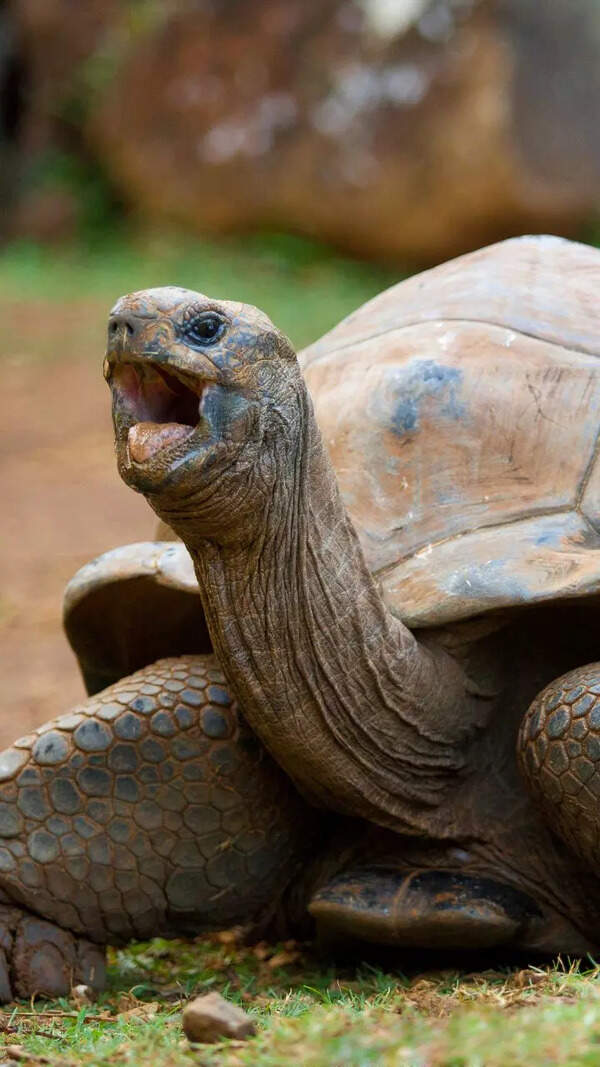Trending
Crocodiles vs Alligators vs Gharials: Know the key differences, conservation status, habitat and distribution
The article highlights the distinct adaptations and conservation statuses of crocodiles, alligators, and gharials. Crocodiles with their V-shaped snouts and salt glands thrive in saltwater, alligators prefer freshwater with U-shaped snouts, and gharials, known for thin snouts, reside in freshwater rivers. Gharials are critically endangered, while crocodiles and alligators remain vulnerable.

Crocodiles, alligators, and gharials are fascinating reptiles that share many similarities, yet they belong to distinct families: Crocodylidae, Alligatoridae, and Gavialidae, respectively. Found in various parts of the world, these ancient creatures differ in physical features, behaviour, and habitat preferences.
Crocodiles are known for their V-shaped snouts and are mostly found in saltwater environments across Africa, Asia, and the Americas.
The differences in snout shape, habitat preference, and feeding strategies highlight the diverse evolutionary paths taken by these ancient reptiles. Below are the highlighted differences between the crocodiles, alligators and gharials on the basis of their characteristics, conservation status and habitat.
Crocodiles, members of the family Crocodylidae, are easily recognized by their long, pointed, V-shaped snouts. Their jaws are of similar width, allowing their upper and lower teeth to interlock, providing a strong grip. Crocodiles are primarily found in saltwater or brackish environments and have specialised salt glands that help them excrete excess salt. They possess sensory organs located on both their jaws and body, enhancing their ability to detect prey. Capable of reaching speeds up to 20 mph, crocodiles can grow up to 17 feet in length and weigh as much as 2200 lbs. They have a formidable bite force of around 3500 PSI and can live up to 70 years. The largest population of crocodiles lives in Central Africa. The Nile crocodile, the most common in Africa, is also one of the largest living reptiles and one of the deadliest too. Some Nile crocodiles can approach the size and weight of the saltwater crocodile, which is considered the largest reptile on Earth. Crocodiles are solitary beings that eat variety of marine animals and aquatic organisms. They can be seen congregating in large numbers only during the mating season.
Alligators
Alligators, part of the family Alligatoridae, are characterised by their round, U-shaped snouts and a wider upper jaw that overlaps the lower jaw, causing the lower teeth to be hidden when their mouth is closed. They are predominantly found in freshwater environments and lack salt glands, distinguishing them from some other crocodilian species. Alligators have sensory organs located on their jaws, aiding in detecting prey. They can reach speeds of up to 30 mph and grow up to 14 feet in length, with a weight that can exceed 1000 lbs. Their powerful bite force measures around 2900 PSI. Alligators typically have a lifespan of up to 50 years. Alligators are unique animals as it has been found that temperature determines the sex of the creature. The researchers say that sex is decided at the time of hatching and remains irreversible. If the temperature of egg incubation is 30 degree celsius or below then females are produced, if the temperature is more than 34 degree celsius then males are produced.
Gharials
Gharials, or fish-eating crocodiles from the family Gavialidae, are notable for their long, thin, and pointed snouts, which are perfectly adapted for catching fish. Their large front teeth and narrower lower jaw make them highly efficient predators in their freshwater river habitats. Equipped with salt glands, they can excrete excess salt, allowing them to thrive in their environment. Sensory organs around their jaws enhance their ability to detect prey, making them formidable hunters. Despite their impressive size, reaching up to 15 feet in length and weighing as much as 2000 lbs, gharials can move at speeds of up to 15 mph. Their bite force is around 2006 PSI, and they have a lifespan of 50-60 years. Endemic to South Asia, these remarkable reptiles are a testament to evolutionary adaptation and resilience. Gharials have a exhibit sexual dimorphism, meaning, men and women differ from each other in shape and size. Adult gharials have a bulbous growth at the tip of their snout called 'ghara'-the Hindi word for pot.
The conservation status of a species indicates its likelihood of becoming endangered or extinct in the near future. This status is determined by organizations such as the International Union for Conservation of Nature (IUCN) and is based on factors like population size, trends, habitat loss, and threats from human activity.
Did you like this article? Please let us know in the comments below!
Also Read | List of animals that have natural curls: From wool pigs to curly tarantulas
Crocodiles are known for their V-shaped snouts and are mostly found in saltwater environments across Africa, Asia, and the Americas.
Alligators, with their U-shaped snouts, inhabit freshwater regions in North America and China. Gharials, distinguished by their long, thin snouts, are native to the rivers of India and Nepal. Understanding their differences is crucial for conservation, as these species face various threats due to habitat loss and human activities.
The differences in snout shape, habitat preference, and feeding strategies highlight the diverse evolutionary paths taken by these ancient reptiles. Below are the highlighted differences between the crocodiles, alligators and gharials on the basis of their characteristics, conservation status and habitat.
Difference between crocodiles, alligators, and gharials on the basis of the characteristics
Crocodiles vs Alligators vs Gharials
- Crocodiles
Crocodiles, members of the family Crocodylidae, are easily recognized by their long, pointed, V-shaped snouts. Their jaws are of similar width, allowing their upper and lower teeth to interlock, providing a strong grip. Crocodiles are primarily found in saltwater or brackish environments and have specialised salt glands that help them excrete excess salt. They possess sensory organs located on both their jaws and body, enhancing their ability to detect prey. Capable of reaching speeds up to 20 mph, crocodiles can grow up to 17 feet in length and weigh as much as 2200 lbs. They have a formidable bite force of around 3500 PSI and can live up to 70 years. The largest population of crocodiles lives in Central Africa. The Nile crocodile, the most common in Africa, is also one of the largest living reptiles and one of the deadliest too. Some Nile crocodiles can approach the size and weight of the saltwater crocodile, which is considered the largest reptile on Earth. Crocodiles are solitary beings that eat variety of marine animals and aquatic organisms. They can be seen congregating in large numbers only during the mating season.
Alligators
Alligators, part of the family Alligatoridae, are characterised by their round, U-shaped snouts and a wider upper jaw that overlaps the lower jaw, causing the lower teeth to be hidden when their mouth is closed. They are predominantly found in freshwater environments and lack salt glands, distinguishing them from some other crocodilian species. Alligators have sensory organs located on their jaws, aiding in detecting prey. They can reach speeds of up to 30 mph and grow up to 14 feet in length, with a weight that can exceed 1000 lbs. Their powerful bite force measures around 2900 PSI. Alligators typically have a lifespan of up to 50 years. Alligators are unique animals as it has been found that temperature determines the sex of the creature. The researchers say that sex is decided at the time of hatching and remains irreversible. If the temperature of egg incubation is 30 degree celsius or below then females are produced, if the temperature is more than 34 degree celsius then males are produced.
Gharials
Gharials, or fish-eating crocodiles from the family Gavialidae, are notable for their long, thin, and pointed snouts, which are perfectly adapted for catching fish. Their large front teeth and narrower lower jaw make them highly efficient predators in their freshwater river habitats. Equipped with salt glands, they can excrete excess salt, allowing them to thrive in their environment. Sensory organs around their jaws enhance their ability to detect prey, making them formidable hunters. Despite their impressive size, reaching up to 15 feet in length and weighing as much as 2000 lbs, gharials can move at speeds of up to 15 mph. Their bite force is around 2006 PSI, and they have a lifespan of 50-60 years. Endemic to South Asia, these remarkable reptiles are a testament to evolutionary adaptation and resilience. Gharials have a exhibit sexual dimorphism, meaning, men and women differ from each other in shape and size. Adult gharials have a bulbous growth at the tip of their snout called 'ghara'-the Hindi word for pot.
Conservation status
The conservation status of a species indicates its likelihood of becoming endangered or extinct in the near future. This status is determined by organizations such as the International Union for Conservation of Nature (IUCN) and is based on factors like population size, trends, habitat loss, and threats from human activity.
- Alligators and Crocodiles: These reptiles are categorized as vulnerable, meaning they are at risk of becoming endangered if their current population trends continue. Vulnerability is often due to habitat destruction, pollution, and illegal hunting, but conservation efforts have helped stabilize some populations.
- Gharials: These are categorized as critically endangered, a status given to species that face an extremely high risk of extinction in the wild. Gharials, a type of crocodilian with a long, narrow snout, were once thought to be extinct. However, around 650 adults have been found globally. They face severe threats from habitat loss, water pollution, and fishing activities. Conservation efforts are needed with a keen emergency.
Crocodiles vs Alligators vs Gharials: Habitat and distribution
- Crocodiles: Found in the United States, Africa, Asia, and Australia. In India, Mugger crocodiles are widespread, while saltwater crocodiles inhabit the east.
- Alligators: Primarily found in eastern China and the southeastern United States.
- Gharials: The rarest of the three, native to India, Bangladesh, Pakistan, and neighbouring countries. They live in several Indian rivers, including the Chambal, Ganga, Yamuna, Kali, Kosi, and Gandak.
Did you like this article? Please let us know in the comments below!
Also Read | List of animals that have natural curls: From wool pigs to curly tarantulas
End of Article
FOLLOW US ON SOCIAL MEDIA










